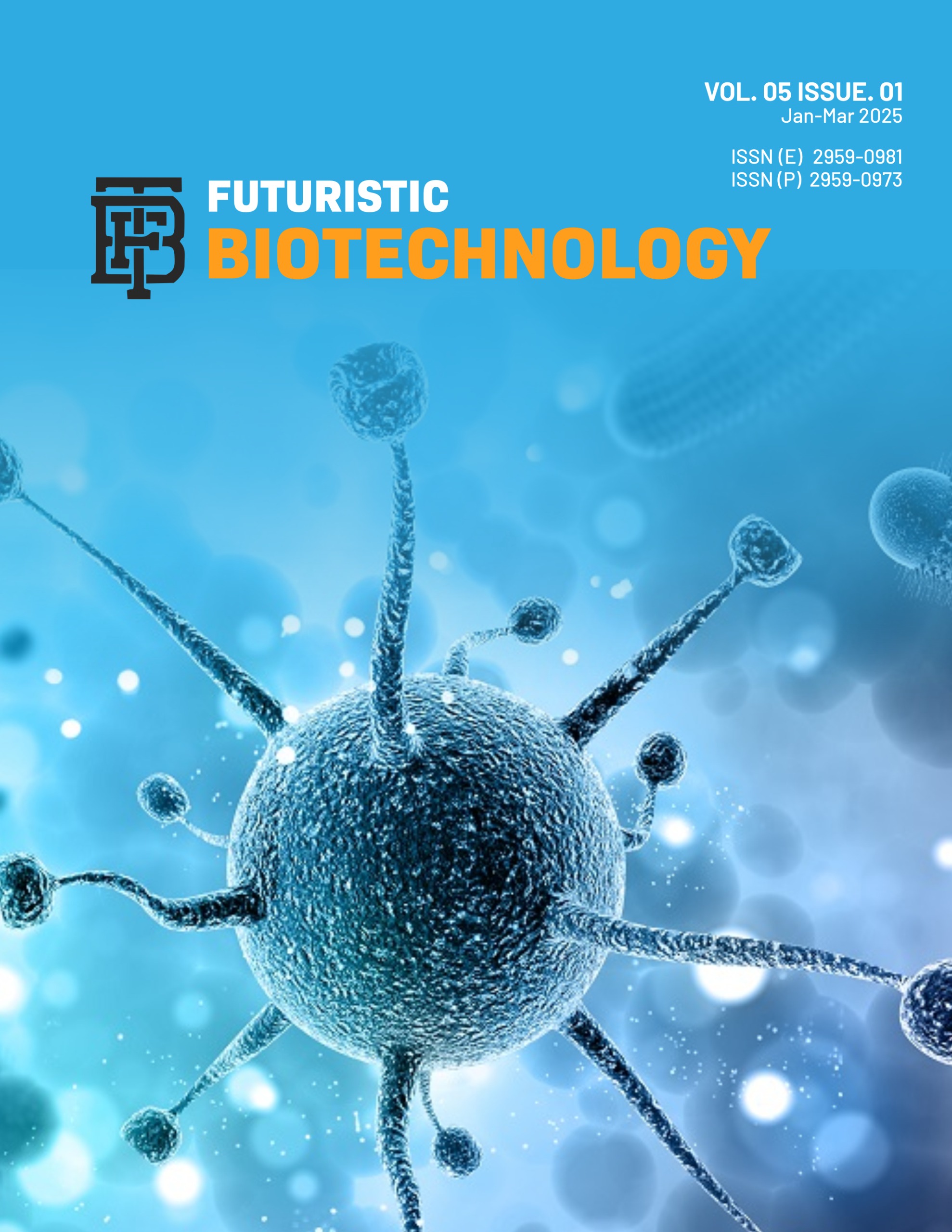Genetics of Cotton Fiber Color: Unveiling the Mechanisms and Exploring Gene-Based Approaches for Color Expression
Genetics of Cotton Fiber: Exploring Gene-Based Approaches
DOI:
https://doi.org/10.54393/fbt.v5i1.166Keywords:
Naturally Colored Cotton, Genetics Mechanism, Pigment Biosynthesis, Color ExpressionAbstract
Cotton is a vital natural fiber, and its color significantly impacts its commercial value and marketability. Traditional cotton cultivation focuses on white fibers, but naturally colored cotton (NCC) is gaining attention due to its potential for sustainable and environmentally friendly textile production. This review explores the genetics and molecular mechanisms underlying cotton fiber color, focusing primarily on anthocyanins and gossypol pigments. We discuss the role of key genes involved in pigment biosynthesis and regulatory pathways. Additionally, we analyze the potential of gene-based color expression approaches, including traditional breeding and genetic engineering. We highlight the advantages and limitations of each approach and discuss future research directions for developing NCC varieties with improved fiber quality, yield, and color diversity.
References
Barros MA, Silva CR, Lima LM, Farias FJ, Ramos GA, Santos RC. A Review On Evolution of Cotton in Brazil: GM, White, and Colored Cultivars. Journal of Natural Fibers. 2022 Jan; 19(1): 209-21. doi: 10.1080/15440478.2020.1738306.
Buainain AM, Alves E, Silveira JM, Navarro Z. The Rural World in 21st Century Brazil. The Formation of a New Agrarian and Agricultural Pattern. Embrapa. 2014.
Lee JA and Fang DD. Cotton as a World Crop: Origin, History, and Current Status. Cotton. 2015 Aug; 57: 1-23. doi: 10.2134/agronmonogr57.2013.0019.
Weisburger JH. Comments on the History and Importance of Aromatic and Heterocyclic Amines in Public Health. Mutation Research/Fundamental and Molecular Mechanisms of Mutagenesis. 2002 Sep; 506: 9-20. doi: 10.1016/S0027-5107(02)00147-1.
Nagarajan S, Purushothaman Y, Selvavinayagam M, Govindharaj P, Musthafa A. Studies on Colored Cotton: Biochemical and Genetic Aspects. In Cotton. 2022 Oct. doi: 10.5772/intechopen.104898.
Yan Q, Wang Y, Li Q, Zhang Z, Ding H, Zhang Y et al. Up‐regulation of Gh TT 2- 3A in Cotton Fibres During Secondary Wall Thickening Results in Brown Fibers with Improved Quality. Plant Biotechnology Journal. 2018 Oct; 16(10): 1735-47. doi: 10.1111/pbi.12910.
Rathinamoorthy R and Parthiban M. Colored Cotton: Novel Eco-Friendly Textile Material for the Future. Handbook of Ecomaterials. 2019; 3: 1499-519. doi: 10.1007/978-3-319-68255-6_91.
Günaydin GK, Avinc O, Palamutcu S, Yavas A, Soydan AS. Naturally Colored Organic Cotton and Naturally Colored Cotton Fiber Production. Organic Cotton: Is it a Sustainable Solution? 2019: 81-99. doi: 10.1007/978-981-10-8782-0_4.
Lv YP, Zhao G, Xie YF, Owusu AG, Wu Y, Gao JS. Transcriptome and Metabolome Profiling Unveil Pigment Formation Variations in Brown Cotton Lines (Gossypium Hirsutum L.). International Journal of Molecular Sciences. 2023 Mar; 24(6): 5249. doi: 10.3390/ijms24065249,
Crews PC and Hustvedt G. The Ultraviolet Protection Factor of Naturally-Pigmented Cotton. 2005.
Kibria G, Repon MR, Hossain MF, Islam T, Jalil MA, Aljabri MD et al. UV-Blocking Cotton Fabric Design for Comfortable Summer Wears: Factors, Durability and Nanomaterials. Cellulose. 2022 Sep; 29(14): 7555-85. doi: 10.1007/s10570-022-04710-7.
Naoumkina M, Thyssen GN, Fang DD, Jenkins JN, McCarty JC, Florane CB. Genetic and Transcriptomic Dissection of the Fiber Length Trait from A Cotton (Gossypium Hirsutum L.) MAGIC Population. BMC Genomics. 2019 Dec; 20: 1-4. doi: 10.1186/s12864-019-5427-5.
Peng Z, Gao Q, Luo C, Gong W, Tang S, Zhang X et al. Flavonoid Biosynthetic and Starch and Sucrose Metabolic Pathways Are Involved in the Pigmentation of Naturally Brown-Colored Cotton Fibers. Industrial Crops and Products. 2020 Dec; 158: 113045. doi: 10.1016/j.indcrop.2020.113045.
Shi S, Tang R, Hao X, Tang S, Chen W, Jiang C et al. Integrative Transcriptomic and Metabolic Analyses Reveal That Flavonoid Biosynthesis Is the Key Pathway Regulating Pigment Deposition in Naturally Brown Cotton Fibers. Plants. 2024 Jul; 13(15): 2028. doi: 10.3390/plants13152028.
Zheng H, Duan B, Yuan B, Chen Z, Yu D, Ke L et al. Flavanone and Flavonoid Hydroxylase Genes Regulate Fiber Color Formation in Naturally Colored Cotton. The Crop Journal. 2023 Jun; 11(3): 766-73. doi: 10.1016/j.cj.2022.10.004.
Mei J, Niu Q, Xu K, Huang Y, Bai S, Zhu J et al. GhmiR858 Inhibits the Accumulation of Proanthocyanidins by Targeting Ghtt2l in Cotton (Gossypium Hirsutum). Journal of Agricultural and Food Chemistry. 2023 Oct; 71(41): 15341-51. doi: 10.1021/acs.jafc.3c03884.
Chen W, Zhang M, Zhang G, Li P, Ma F. Differential Regulation of Anthocyanin Synthesis in Apple Peel Under Different Sunlight Intensities. International Journal of Molecular Sciences. 2019 Dec; 20(23): 6060. doi: 10.3390/ijms20236060.
Wang R, Ren C, Dong S, Chen C, Xian B, Wu Q et al. Integrated Metabolomics and Transcriptome Analysis of Flavonoid Biosynthesis in Safflower (Carthamus Tinctorius L.) with Different Colors. Frontiers in Plant Science. 2021 Jul; 12: 712038. doi: 10.3389/fpls.2021.712038.
Yang H, An W, Gu Y, Peng J, Jiang Y, Li J et al. Integrative Metabolomic and Transcriptomic Analysis Reveals the Mechanism of Specific Color Formation in Phoebe Zhennan Heartwood. International Journal of Molecular Sciences. 2022 Nov; 23(21): 13569. doi: 10.3390/ijms232113569.
Liang CY, Rengasamy KP, Huang LM, Hsu CC, Jeng MF, Chen WH et al. Assessment of Violet-Blue Color Formation in Phalaenopsis Orchids. BioMed Central Plant Biology. 2020 Dec; 20: 1-6. doi: 10.1186/s12870-020-02402-7.
Khan AQ, Li Z, Ahmed MM, Wang P, Zhang X, Tu L. Eriodictyol Can Modulate Cellular Auxin Gradients to Efficiently Promote in Vitro Cotton Fibre Development. BioMed Central Plant Biology. 2019 Dec; 19: 1-5. doi: 10.1186/s12870-019-2054-x.
Gao J, Shen LI, Yuan J, Zheng H, Su Q, Yang W et al. Functional Analysis of GhCHS, GhANR and GhLAR in Colored Fiber Formation of Gossypium Hirsutum L. BioMed Central Plant Biology. 2019 Dec; 19: 1-8. doi: 10.1186/s12870-019-2065-7.
Zhou L, He Y, Li J, Liu Y, Chen H. CBFs Function in Anthocyanin Biosynthesis by Interacting with MYB113 in Eggplant (Solanum Melongena L.). Plant and Cell Physiology. 2020 Feb; 61(2): 416-26. doi: 10.1093/pcp/pcz209.
Dai M, Kang X, Wang Y, Huang S, Guo Y, Wang R et al. Functional Characterization of Flavanone 3-Hydroxylase (F3H) and Its Role in Anthocyanin and Flavonoid Biosynthesis in Mulberry. Molecules. 2022 May; 27(10): 3341. doi: 10.3390/molecules27103341.
Qi Y, Lou Q, Quan Y, Liu Y, Wang Y. Flower-Specific Expression of the Phalaenopsis Flavonoid 3′, 5′-Hydoxylase Modifies Flower Color Pigmentation in Petunia and Lilium. Plant Cell, Tissue and Organ Culture. 2013 Nov; 115: 263-73. doi: 10.1007/s11240-013-0359-2.
Wang N, Zhang B, Yao T, Shen C, Wen T, Zhang R et al. Re Enhances Anthocyanin and Proanthocyanidin Accumulation to Produce Red Foliated Cotton and Brown Fiber. Plant Physiology. 2022 Jul; 189(3): 1466-81. doi: 10.1093/plphys/kiac118.
Liu LY, Jia MZ, Wang SN, Han S, Jiang J. Identification and Characterization of Cotton Phytochrome-Interacting Factors in Temperature-Dependent Flowering. Journal of Experimental Botany. 2023 Jun; 74(12): 3765-80. doi: 10.1093/jxb/erad119.
Zu QL, Qu YY, Ni ZY, Zheng K, Chen Q, Chen QJ. The Chalcone Isomerase Family in Cotton: Whole-Genome Bioinformatic and Expression Analyses of the Gossypium Barbadense L. Response to Fusarium Wilt Infection. Genes. 2019 Dec; 10(12): 1006. doi: 10.3390/genes10121006.
Malik W, Anjum N, Usman Khan M, Abid MA, Ashraf J, Zhang R et al. Genomics of Naturally Colored Cotton: A Way Forward to Initiate Precision Breeding. In Cotton Precision Breeding. Cham: Springer International Publishing. 2021 Jun: 173-195. doi: 10.1007/978-3-030-64504-5_8.
Majeed S, Chaudhary MT, Mubarik MS, Rana IA, Shaban M, Tan DK et al. Genetics of Biochemical Attributes Regulating Morpho-Physiology of Upland Cotton Under High Temperature Conditions. Journal of Cotton Research. 2024 Jan; 7(1): 3. doi: 10.1186/s42397-023-00164-9.
Younas A, Riaz N, Rashid M, Fiaz S, Tufail A, Noreen Z et al. Modification in Conventional Methods and Modern Plant Breeding Techniques to Enhance Genetic Gain for Future Food Security. Crop Biofortification: Biotechnological Approaches for Achieving Nutritional Security Under Changing Climate. 2025 Feb: 377-94. doi: 10.1002/9781394273270.ch22.
Çakmak F, Çinar VM, Balci Ş, Ünay A. Yield and Fiber Quality Balance in Upland Cotton (Gossypium Hirsutum L.) Breeding. Bangladesh Journal of Botany. 2023 Jun; 52(2): 283-90. doi: 10.3329/bjb.v52i2.67025.
Madartov B, Abdiev F, Mavlonova N, Shukurov K. Using the Dominance Coefficient in Assessing Cotton Families. In E3S Web of Conferences. 2023; 381(01014). doi: 10.1051/e3sconf/202338101014.
Kholmurodova G, Barotova A, Namazov S, Yuldasheva R, Jumashev M. Creation of Selected Items with High Fiber Yield and Length Based On Cotton Composite Hybrids. In E3S Web of Conferences. 2023; 371: 01039. EDP Sciences. doi: 10.1051/e3sconf/202337101039.
Razzaq A, Saleem F, Kanwal M, Mustafa G, Yousaf S, Imran Arshad HM et al. Modern Trends in Plant Genome Editing: An Inclusive Review of the CRISPR/Cas9 Toolbox. International Journal of Molecular Sciences. 2019 Aug; 20(16): 4045. doi: 10.3390/ijms20164045.
Raza A, Mubarik MS, Sharif R, Habib M, Jabeen W, Zhang C et al. Developing Drought‐Smart, Ready‐to‐Grow Future Crops. The Plant Genome. 2023 Mar; 16(1): e20279. doi: 10.1002/tpg2.20279.
Downloads
Published
How to Cite
Issue
Section
License
Copyright (c) 2025 Futuristic Biotechnology

This work is licensed under a Creative Commons Attribution 4.0 International License.
This is an open-access journal and all the published articles / items are distributed under the terms of the Creative Commons Attribution License, which permits unrestricted use, distribution, and reproduction in any medium, provided the original author and source are credited. For comments editor@fbtjournal.com











